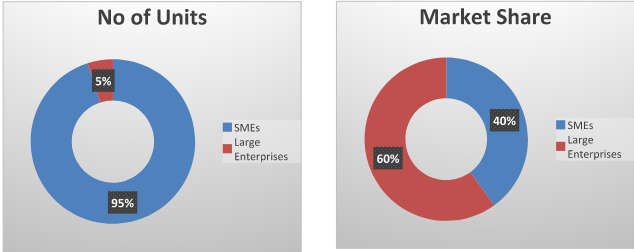In every other household in India, one can find someone who wants to open their own business. They want to have some source of income of their own. Until a few decades or so ago, few took the path of entrepreneurship. But awareness and subsidies about and in the small and medium enterprise (SME) sector in the past five decades has given people the confidence to take the path of entrepreneurship more.
Today in India, 95% of total Industrial units belong to the SME’s, and rest 5% to the corporate (Large Enterprises & Conglomerates). But, on the contrary, the output of these 95% industrial units is only 40%; rest 60% output is being made by the remaining 5% Industrial units which belong to the Large Enterprise. So the question here is why such a wide gap? Why 5% of the corporate players are having a market share of more than 50%? The simple answer to this is the “Way of Working”.

Data Source: source: https://evoma.com/business-centre/sme-sector-in-india-statistics-trends-reports/
Even though the SME sector is growing, it still remains quite unorganized in its work structure. There comes a stage, when most of the SME business reaches a threshold point and growing beyond it becomes difficult for the SME businessman. When one starts something from scratch, no matter how small it is every little attention to detail matters. From idea generation, till the product/service reaches the designated customer everything needs to be planned, organized and monitored. SME businessmen do not realize the importance of organizing, so he becomes the kingpin of their business, wherein business may stop to operate if they are personally not involved in the working of their enterprise. SME’s are not the only one who suffers from an unorganized structure of working. Even big business and conglomerates also face certain constraints due to the way they work within the confines of their organized organization. Blame Game or no accountability, not taking responsibility for one’s actions, ego clashes are some of the common problem, due to which large businesses often suffer. The industrial world is a dynamic one. Work culture is getting influenced from various western cultures. Technology has been evolving every single day. The senior department manager’s and the head of departments often try to incorporate these changes but on a bigger scale, it does get difficult.
These Business problems of India were been closely analyzed by a team of experts and they decided to find a solution to this problem. They are trying to present to India a new outlook on the “Organized Way of Working”. The trio of Nikhil Agarwal, Rupal Shah & Varun Shah has till date got a solution to this problem and helped many businesses in this country to overcome their problems related to unorganized way of working and grow beyond their stagnancy stage.

Left to right: Varun Shah, Dr. Rupal Agarwal, Nikhil Agarwal
Nikhil Agarwal, a business process automation guru, from Your Retail Coach (YRC), stresses on keeping things simple. Every business entity whether big or small has started using complex approaches as a way of working and to solve the easiest of problems. To successfully implement business automation in an enterprise, adopt clean, simple and organized ways. According to Nikhil, “Adopting the right Business Management Tools and defining/upgrading SOPs (i.e. Standard Operating Procedures) is a basic necessity for every Business and is no more an option”.
Dr. Rupal Agarwal, Business Strategy and Planning Guru, from Your Retail Coach (YRC), feels that once the business starts gaining a little success, the top management starts focusing on that aspect of business only. They are unable to balance out the working of each departments and the control is somehow lost. There is no planning and monitoring on the process of working. For maximum optimization of the materials, operations and resources it is important to do a regular internal review. This is a very important part of organized working. It is often ignored and left in the hands of individuals handling a particular task. The levels of authority and responsibility for actions taken need to be clearly defined. Many panic situations and problems arise in our day-to-day working, wherein the senior management must ensure they give a long term solution to such problems, so that if they arise again, it can be handled in the same way by the team members rather than finding a solution to a similar problem and solving it personally every single time. This change will first start from the Top Level Management. They must adopt a planned and organized way of working to make the work of their employees easier. Business management tools must be adopted to increase focus and level of productivity.
With the sole aim of contributing towards “Organized India”, Nikhil Agarwal, Dr. Rupal Shah Agarwal & Varun Shah, have helped 100+ Retail Organization till date to adopt “Organized way of working” and have unleashed their potential, where in average growth after this change has increased by 40% in the immediate year, which is a significant leap of growth for any business.
PR Source: https://www.prlog.org/12754092-meet-the-experts-who-are-organizing-the-unorganized-retail-in-india.html
To read more articles related to this topic click here: How to Create a Successful Franchising Brand? | How SOPs can Help Doctors | How to write SOPs for Furniture Showroom | How to Develop SOPs for QSR | How to write SOPs for an Apparel Brand | How SOPs will help in Franchise Business Expansion | Six Steps to Writing a Great SOP for Retail | How to Write SOP for Marketing







